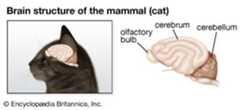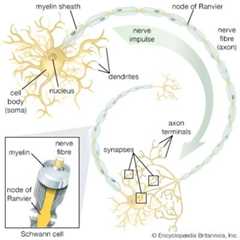Our editors will review what you’ve submitted and determine whether to revise the article.
- San Diego Miramar College - Nervous System (PDF)
- National Center for Biotechnology Information - PubMed Central - Nervous System
- Verywell Health - What You Need to Know About the Nervous System
- Cleveland Clinic - Nervous System
- CORE - Review Information and Efficiency in the Nervous System — A Synthesis (PDF)
- Academia - Nervous System Overview(PDF)
- The University of Hawaiʻi Pressbooks - Anatomy and Physiology - Basic Structure and Function of the Nervous System
- University of Washington - Neuroscience For Kids - Divisions of the Nervous System
- Healthdirect - Nervous system
- Biology LibreTexts - The Nervous System
- OpenStax - Microbiology - Anatomy of the Nervous System
- National Cancer Institute - SEER Training Modules - Organization of the Nervous System
nervous system
- What is the nervous system?
- What are the main parts of the nervous system?
- What is the role of the brain in the nervous system?
- How does the spinal cord contribute to the nervous system?
- What are neurons and what function do they serve in the nervous system?
- How do nerve signals travel through the nervous system?
- What is the difference between the central nervous system and the peripheral nervous system?
- How does the nervous system interact with other systems in the body?
News•
nervous system, organized group ofcells specialized for the conduction of electrochemical stimuli from sensory receptors through a network to the site at which a response occurs.
All living organisms are able to detect changes within themselves and in theirenvironments. Changes in the externalenvironment include those oflight,temperature,sound, motion, andodour, while changes in the internal environment include those in the position of the head and limbs as well as in the internal organs. Once detected, these internal and external changes must be analyzed and acted upon in order to survive. Aslife on Earth evolved and the environment became more complex, the survival of organisms depended upon how well they could respond to changes in their surroundings. One factor necessary for survival was a speedy reaction or response. Since communication from one cell to another by chemical means was too slow to be adequate for survival, a system evolved that allowed for faster reaction. That system was the nervous system, which is based upon the almost instantaneous transmission of electrical impulses from one region of the body to another along specializednerve cells calledneurons.
Nervous systems are of two general types, diffuse and centralized. In the diffuse type of system, found in lowerinvertebrates, there is nobrain, and neurons are distributed throughout the organism in a netlike pattern. In the centralized systems of higher invertebrates andvertebrates, a portion of the nervous system has a dominant role in coordinating information and directing responses. This centralization reaches its culmination in vertebrates, which have a well-developed brain andspinal cord. Impulses are carried to and from the brain and spinal cord by nerve fibres that make up theperipheral nervous system.
This article begins with a discussion of the general features of nervous systems—that is, their function of responding to stimuli and the rather uniform electrochemical processes by which they generate a response. Following that is a discussion of the various types of nervous systems, from the simplest to the most complex.
Form and function of nervous systems
Stimulus-response coordination
The simplest type of response is a direct one-to-one stimulus-response reaction. A change in the environment is thestimulus; the reaction of the organism to it is the response. In single-celled organisms, the response is the result of a property of the cell fluid calledirritability. In simple organisms, such asalgae,protozoans, andfungi, a response in which the organism moves toward or away from the stimulus is calledtaxis. In larger and more complicated organisms—those in which response involves the synchronization andintegration of events in different parts of the body—a control mechanism, or controller, is located between the stimulus and the response. In multicellular organisms, this controller consists of two basic mechanisms by which integration is achieved—chemical regulation and nervous regulation.

Inchemical regulation, substances calledhormones are produced by well-defined groups of cells and are either diffused or carried by theblood to other areas of the body where they act ontarget cells and influencemetabolism or induce synthesis of other substances. The changes resulting from hormonal action are expressed in the organism as influences on, or alterations in, form,growth,reproduction, and behaviour.
Plants respond to a variety of externalstimuli by utilizing hormones ascontrollers in a stimulus-response system. Directional responses of movement are known astropisms and are positive when the movement is toward the stimulus and negative when it is away from the stimulus. When a seed germinates, the growingstem turns upward toward the light, and theroots turn downward away from the light. Thus, the stem shows positive phototropism and negative geotropism, while the roots show negative phototropism and positive geotropism. In this example, light and gravity are the stimuli, and directional growth is the response. The controllers are certain hormonessynthesized by cells in the tips of the plant stems. These hormones, known asauxins, diffuse through the tissues beneath the stem tip and concentrate toward the shaded side, causing elongation of these cells and, thus, a bending of the tip toward the light. The end result is the maintenance of the plant in an optimal condition with respect to light.

Inanimals, in addition to chemical regulation via theendocrine system, there is another integrative system called thenervous system. A nervous system can be defined as an organized group of cells, called neurons, specialized for the conduction of an impulse—an excited state—from asensory receptor through a nerve network to an effector, the site at which the response occurs.
Organisms that possess a nervous system are capable of much more complex behaviour than are organisms that do not. The nervous system, specialized for the conduction of impulses, allows rapid responses to environmental stimuli. Many responses mediated by the nervous system are directed toward preserving the status quo, orhomeostasis, of the animal. Stimuli that tend to displace or disrupt some part of the organism call forth a response that results in reduction of the adverse effects and a return to a more normal condition. Organisms with a nervous system are also capable of a second group of functions that initiate a variety of behaviour patterns. Animals may go through periods of exploratory or appetitive behaviour, nest building, andmigration. Although these activities arebeneficial to the survival of the species, they are not always performed by the individual in response to an individual need or stimulus. Finally, learned behaviour can be superimposed on both the homeostatic and initiating functions of the nervous system.
Intracellular systems
All living cells have the property of irritability, or responsiveness to environmental stimuli, which can affect the cell in different ways, producing, for example, electrical, chemical, or mechanical changes. These changes are expressed as a response, which may be the release of secretory products bygland cells, the contraction ofmuscle cells, the bending of a plant-stem cell, or the beating of whiplike “hairs,” orcilia, by ciliated cells.
- On the Web:
- Cleveland Clinic - Nervous System (Oct. 09, 2025)
The responsiveness of a single cell can be illustrated by the behaviour of the relatively simpleamoeba. Unlike some other protozoans, an amoeba lacks highly developed structures that function in the reception of stimuli and in the production or conduction of a response. The amoeba behaves as though it had a nervous system, however, because the general responsiveness of itscytoplasm serves the functions of a nervous system. An excitation produced by a stimulus is conducted to other parts of the cell and evokes a response by the animal. An amoeba will move to a region of a certain level of light. It will be attracted by chemicals given off by foods and exhibit a feeding response. It will also withdraw from a region with noxious chemicals and exhibit an avoidance reaction upon contacting other objects.

















